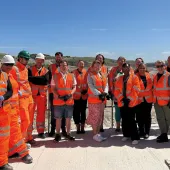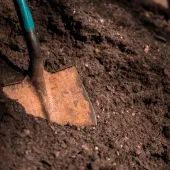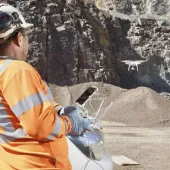Annual Conference 2003 Review

A report on The Institute of Quarrying's annual conference held in Newport
The 2003 annual conference was the first occasion on which the conference had been hosted by the South Wales branch and the president made special mention of the substantial contribution made by the local organizing committee, which comprised Bryn Osgood, Graham Barrie, Tom Emery, Dudley Lloyd, Rob Pearce and David Goodman.
The venue for the conference was the Newport Hilton Hotel, conveniently situated near the junction between the M4 and A449, the route to South Wales from the Midlands and the North.
Just over 140 delegates registered for the conference including Brian Bartley, a former president of The Institute from New Zealand, accompanied by his wife Elaine, and Frans van Wyk, deputy chairman of the Southern Africa branch, with his wife Dina.
The symposium was arranged as three consecutive sessions each chaired by a member of The Institute in the following order: Anthony Morgan, regional director, Tarmac (South Wales); Richard Millard, director, RMC Aggregates (South Wales); and Bryn Osgood, production manager, United Marine Aggregates.
The proceedings began with a welcome by Bryn Osgood, chairman of the South Wales branch, who expressed the enthusiasm of the branch to host the annual conference for the first time. The welcome was followed by the presentation of prizes to students who had excelled in the recent Professional Examinations and of awards to authors of the best papers by the president, John Hopkins.
First among the prizewinners was Shirley Ann Everett who won both the Clugston and Goodwin Barsby Awards and came runner-up in the Preston Award. Several students won two prizes. Matthew Clements was runner-up for both the Preston Award and the Ransome Rapier Award, and Matthew Dunstone won the Preston Award and came runner-up in the Coles Award. Next, Gary Morgan collected first prize in the Ransome Rapier Award and second prize in the Rexnord Award. The Coles Award was won by Rachel Ball and the Tilcon Award by Christopher Snowball. Kieren McCabe was the runner-up in the Goodwin Barsby Award. Regrettably, Alan Bate, winner of the Rexnord Award and runner-up for the Tilcon Award, was unable to attend the conference.
The Marston Award, for the best paper presented to a branch meeting, was given to Josephine Ford for her paper on the recycling of bituminous material. Josephine has just graduated from Doncaster College and was an active member of the Yorkshire branch during her studies. The Ruston Bucyrus Award went to David Highley of the British Geological Survey for his paper on the environmental constraints surrounding exploitation of mineral resources in the UK, which was presented at ‘Minerals 2002’.
Finally, and most appropriately, the president invited Bryn Osgood and David Goodman to accept the President’s Branch Trophy on behalf of the South Wales branch for organizing the most innovative and active programme of events during the session 2002/2003.
The keynote address was given by Mike Foster, executive director, RMC Group, who used the title of the symposium, ‘The extraction industry — the pathway to social acceptability’ to set the theme for the day. He said that RMC had made some progress along this pathway by creating and maintaining a safer and healthier workplace, by demonstrating sustainability through recycling, by caring for and improving the environment, by being a good neighbour, and by creating employment. In his opinion the industry had achieved much but there was still more to do.
Second to speak was Terry Rose, divisional director (Wales and South West), Health and Safety Executive, and former chairman of the Quarries National Joint Advisory Committee (QNJAC), on the very important issue of the health and safety of the workforce. In his presentation entitled ‘Where we were, where we are and the future’, Terry stated that quarrying was included among the dangerous industries, like deep-sea fishing, where death and injuries were tolerated. This was no longer acceptable to modern society but old attitudes were hard to overcome. The greatest steps towards a safer industry were the report by Lord Robens, the consequent Health & Safety at Work etc Act of 1974 and creation of the Health and Safety Commission. For the first time government, employer and employee were all involved in improving safety. The new Quarries Regulations 1999 then led to the ‘Hard Targets’ initiative and Terry was pleased to note that the industry was on target to reduce fatalities and injuries by 50%. For the future, he warned against complacency and loss of what had been achieved and hoped that the industry and HSE could continue to work together to reduce the incidence of occupational diseases, the ‘health’ in health and safety.
According to Stephen Cox, partner in Wardell Armstrong, progress along ‘the pathway’ required compliance with regulations, minimal environmental impact and maximum benefit to the community. He drew the attention of delegates to a photograph of the reformed and restored ‘Old Smokey’ tip above Tylorstown, reproduced on the conference brochure, and informed them that this tip was socially unacceptable even before the Aberfan Disaster. Environmental Impact Assessment and Environmental Statements were a legal requirement of the planning process but should also be seen as an opportunity to reassure the local community that no unexpected impacts would occur. He gave advice on minimizing impact on the environment and especially warned the industry to survey sites for protected plant and animal species. Stephen argued that the benefits of mineral development are real and should be emphasized at the planning stage, including employment, increased biodiversity, rehabilitation of derelict land and enhanced after-use.
The contribution to the sustainability of mineral extraction by selected technologies was explained by Richard Connelly of SRK Consulting. Geotechnical engineering ensured stable tips and slopes and permitted maximum extraction of the resource. Improved water management and treatment reduced both abstraction and discharges. GIS and mine-planning software were valuable tools affording visualization of projected developments and communication of information both internally and to the public. Potential impacts could be predicted and avoided and alternative plans for restoration and closure previewed.
The Camborne School of Mines offers degree courses in mining and quarrying and has been conducting research into the causes of accidents in the quarrying industry, so Dr Patrick Foster was in a good position to give a talk entitled ‘Training people to meet the need’. The need is for skilled, competent employees who also work safely and Pat provided advice on the content of safety training.
The sustainability of quarrying in the UK was set in an international context by Dr John Groom, vice-president, safety, health and environment of Anglo American. He explained that a group of chief executives of international mining companies started the Global Mining Initiative (GMI) when they recognized that the industry was facing three major challenges: access to land for mining, access to markets for mineral products perceived as polluting or non-recyclable, and poor reputation. The challenge has increased recently as the World Bank debates the principle of funding for mining projects.
A major independent investigation of the sustainability of mining was commissioned, called ‘Mining, minerals and sustainable development’ (MMSD), and a large multi-stakeholder conference was held in Toronto on the tenth anniversary of the Rio Summit of 1992. This put the mining industry in a good position to demonstrate sustainability before the Johannesburg World Summit. The International Council for Mining and Metals (ICMM) was founded to represent the industry and to develop sustainability indicators in collaboration with the Global Reporting Initiative. At a local level, quarry operators can contribute to sustainability by conserving water, energy and biodiversity, and improving safety.
The afternoon began with an extra presentation by Cedric Hollinsworth, chairman of the EPIC HR committee, who demonstrated an interactive CD containing information on careers in the quarrying industry. This CD has been specially produced by EPIC Training Ltd to address the problem of recruiting able, young people into the industry and will be available shortly.
Two suppliers of equipment to the quarrying industry then took the opportunity to inform delegates of technical developments which would increase the sustainability of the industry. Greg Gardner of Caterpillar focused on the development of low-emission diesel engines that consumed their own waste oil and the re-use of machine parts through reconditioning and remanufacturing.
Ilpo Auranen of Metso described several means by which processing plant was being constructed to reduce environmental impact including the use of mobile crushing and screening plant to allow small deposits of minerals to be exploited close to urban areas, thereby reducing the cost and environmental impacts of transport.
Lembit Opik, well recognized Liberal Democrat MP for Montgomeryshire, introduced himself as a ‘realistic activist’ who appreciated that strategy and policy must, eventually, be translated into action. He warned the industry that present-day politicians seem to desire to eliminate hazards rather than manage risk. Thus, they tend to enact legislation to prohibit potentially harmful or annoying activities and the quarrying industry should strive to improve its image and deter burdensome regulation. In his experience the electorate still considered quarrying to be environmentally unfriendly with the main issues being:
- profit before community
- large lorries
- blasting
- slag (waste)
- dirt.
The principle activities of the Government which impacted on quarrying were the Water Bill and Rural Regeneration. To illustrate his point he reported that an amendment to the Aggregates Levy to reward good practice was being given low priority.
On a positive note, however, Lembit considered the Sustainability Fund to be an excellent opportunity for the quarrying industry to practice good public relations and recommended that greater use should be made of this fund.
Continuing the theme of relations with the public, the success of Groundwork UK to engage the community with the quarrying industry through schools, including the RMC Greenlink project, was described by Roger Harmer, head of fundraising and development.
Describing himself as an ‘ageing campaigner’, David Bellamy delivered the last and most energetic lecture of the day without notes or slides. Reminding the audience that he had delivered the McPherson lecture over 10 years ago in 1989, he lamented that the attitude of the public towards quarrying had changed little, partly because the media did not generally publish ‘good news’. He acknowledged that promotion of an environmentally responsible industry was difficult and cited the construction of wind farms as an example of irrational thinking in environmental matters. Nevertheless, it was a fact that the quarrying industry was actively involved in recycling, good quality restoration, creation of valuable after-uses, nature conservation and supply of essential mineral products. In summary, he endorsed the opinion of several speakers that the industry needed to publicize its achievements.
The excellent symposium was preceded and succeeded by social events that were enjoyed by a substantial number of delegates. In a break with tradition, the informal dinner on the night before the symposium took the form of a medieval banquet at Caldicot Castle which was attended by more than 80 people. Demand for the dinner and dance following the symposium exceeded the capacity of the Severn Suite but approximately 180 members and guests appreciated the voices of the internationally renowned Pendyrus Male Choir and danced to the music of ‘City Lights’. The partners’ outing included a visit to the Museum of Welsh Life at St Fagans, near Cardiff, and lunch in the redeveloped Cardiff docklands.








